turn signal INFINITI QX50 2021 User Guide
[x] Cancel search | Manufacturer: INFINITI, Model Year: 2021, Model line: QX50, Model: INFINITI QX50 2021Pages: 542, PDF Size: 3.51 MB
Page 179 of 542
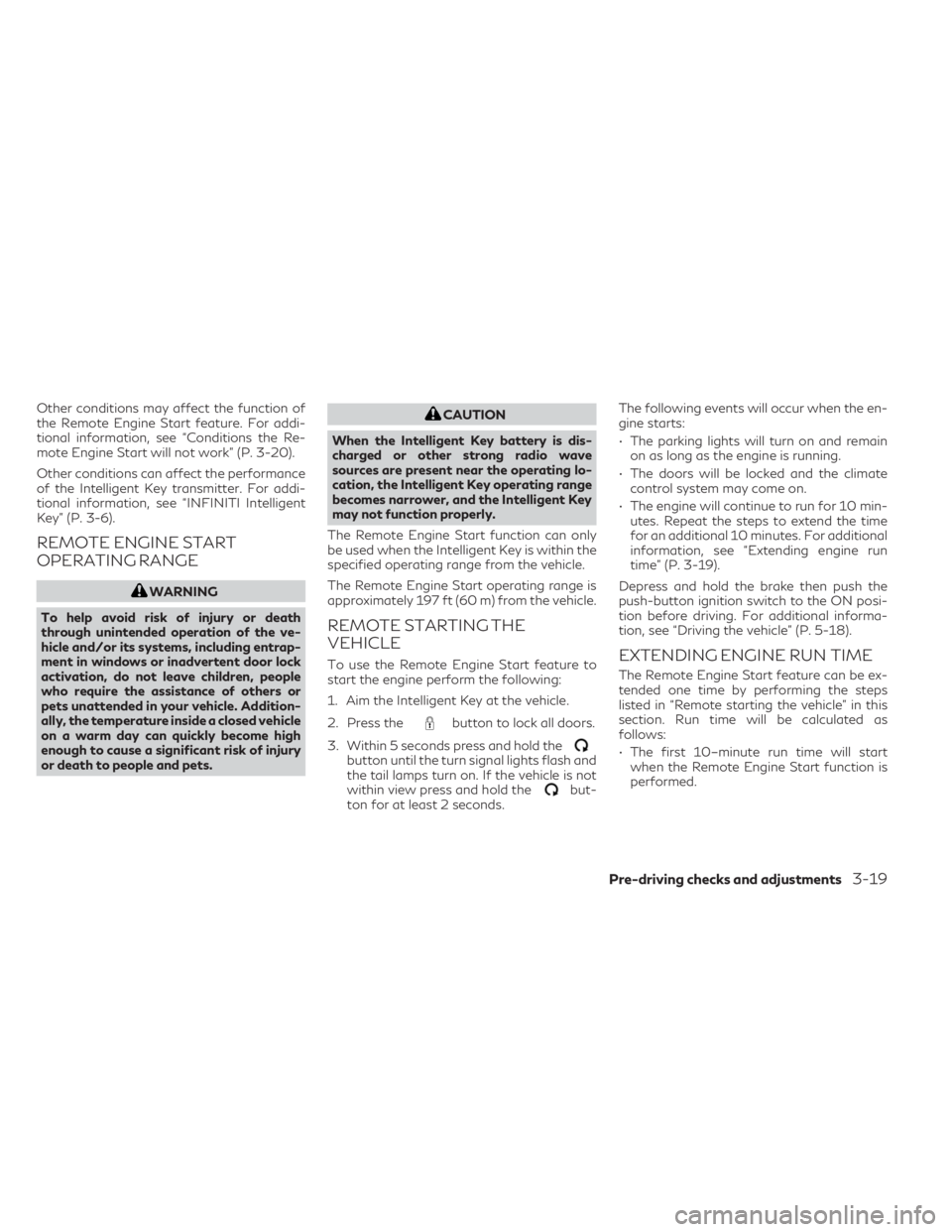
Other conditions may affect the function of
the Remote Engine Start feature. For addi-
tional information, see “Conditions the Re-
mote Engine Start will not work” (P. 3-20).
Other conditions can affect the performance
of the Intelligent Key transmitter. For addi-
tional information, see “INFINITI Intelligent
Key” (P. 3-6).
REMOTE ENGINE START
OPERATING RANGE
WARNING
To help avoid risk of injury or death
through unintended operation of the ve-
hicle and/or its systems, including entrap-
ment in windows or inadvertent door lock
activation, do not leave children, people
who require the assistance of others or
pets unattended in your vehicle. Addition-
ally, the temperature inside a closed vehicle
on a warm day can quickly become high
enough to cause a significant risk of injury
or death to people and pets.
CAUTION
When the Intelligent Key battery is dis-
charged or other strong radio wave
sources are present near the operating lo-
cation, the Intelligent Key operating range
becomes narrower, and the Intelligent Key
may not function properly.
The Remote Engine Start function can only
be used when the Intelligent Key is within the
specified operating range from the vehicle.
The Remote Engine Start operating range is
approximately 197 ft (60 m) from the vehicle.
REMOTE STARTING THE
VEHICLE
To use the Remote Engine Start feature to
start the engine perform the following:
1. Aim the Intelligent Key at the vehicle.
2. Press the
button to lock all doors.
3. Within 5 seconds press and hold the
button until the turn signal lights flash and
the tail lamps turn on. If the vehicle is not
within view press and hold the
but-
ton for at least 2 seconds. The following events will occur when the en-
gine starts:
• The parking lights will turn on and remain
on as long as the engine is running.
• The doors will be locked and the climate control system may come on.
• The engine will continue to run for 10 min- utes. Repeat the steps to extend the time
for an additional 10 minutes. For additional
information, see “Extending engine run
time” (P. 3-19).
Depress and hold the brake then push the
push-button ignition switch to the ON posi-
tion before driving. For additional informa-
tion, see “Driving the vehicle” (P. 5-18).
EXTENDING ENGINE RUN TIME
The Remote Engine Start feature can be ex-
tended one time by performing the steps
listed in “Remote starting the vehicle” in this
section. Run time will be calculated as
follows:
• The first 10–minute run time will start when the Remote Engine Start function is
performed.
Pre-driving checks and adjustments3-19
Page 280 of 542
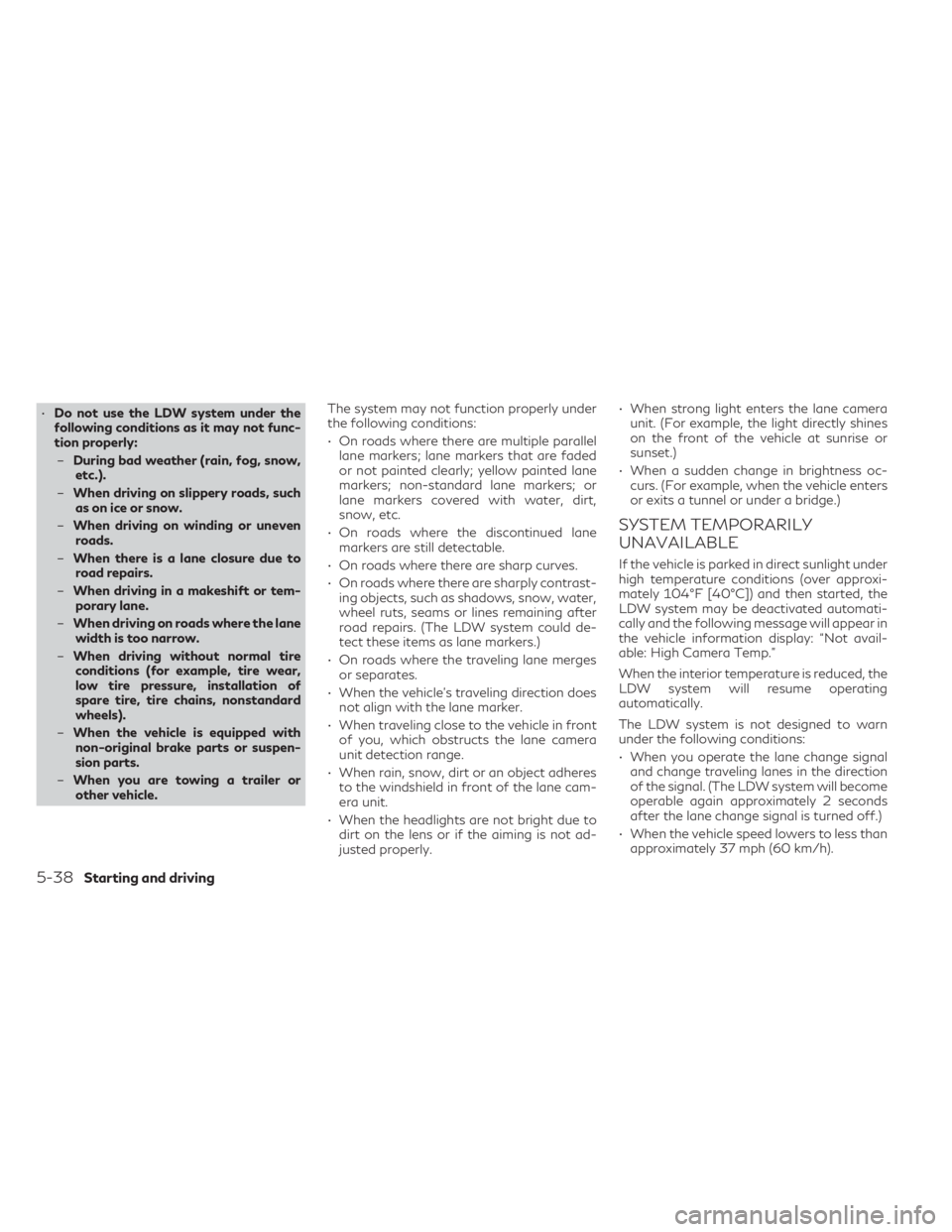
•Do not use the LDW system under the
following conditions as it may not func-
tion properly:
– During bad weather (rain, fog, snow,
etc.).
– When driving on slippery roads, such
as on ice or snow.
– When driving on winding or uneven
roads.
– When there is a lane closure due to
road repairs.
– When driving in a makeshift or tem-
porary lane.
– When driving on roads where the lane
width is too narrow.
– When driving without normal tire
conditions (for example, tire wear,
low tire pressure, installation of
spare tire, tire chains, nonstandard
wheels).
– When the vehicle is equipped with
non-original brake parts or suspen-
sion parts.
– When you are towing a trailer or
other vehicle. The system may not function properly under
the following conditions:
• On roads where there are multiple parallel
lane markers; lane markers that are faded
or not painted clearly; yellow painted lane
markers; non-standard lane markers; or
lane markers covered with water, dirt,
snow, etc.
• On roads where the discontinued lane markers are still detectable.
• On roads where there are sharp curves.
• On roads where there are sharply contrast- ing objects, such as shadows, snow, water,
wheel ruts, seams or lines remaining after
road repairs. (The LDW system could de-
tect these items as lane markers.)
• On roads where the traveling lane merges or separates.
• When the vehicle’s traveling direction does not align with the lane marker.
• When traveling close to the vehicle in front of you, which obstructs the lane camera
unit detection range.
• When rain, snow, dirt or an object adheres to the windshield in front of the lane cam-
era unit.
• When the headlights are not bright due to dirt on the lens or if the aiming is not ad-
justed properly. • When strong light enters the lane camera
unit. (For example, the light directly shines
on the front of the vehicle at sunrise or
sunset.)
• When a sudden change in brightness oc- curs. (For example, when the vehicle enters
or exits a tunnel or under a bridge.)
SYSTEM TEMPORARILY
UNAVAILABLE
If the vehicle is parked in direct sunlight under
high temperature conditions (over approxi-
mately 104°F [40°C]) and then started, the
LDW system may be deactivated automati-
cally and the following message will appear in
the vehicle information display: “Not avail-
able: High Camera Temp.”
When the interior temperature is reduced, the
LDW system will resume operating
automatically.
The LDW system is not designed to warn
under the following conditions:
• When you operate the lane change signaland change traveling lanes in the direction
of the signal. (The LDW system will become
operable again approximately 2 seconds
after the lane change signal is turned off.)
• When the vehicle speed lowers to less than approximately 37 mph (60 km/h).
5-38Starting and driving
Page 285 of 542
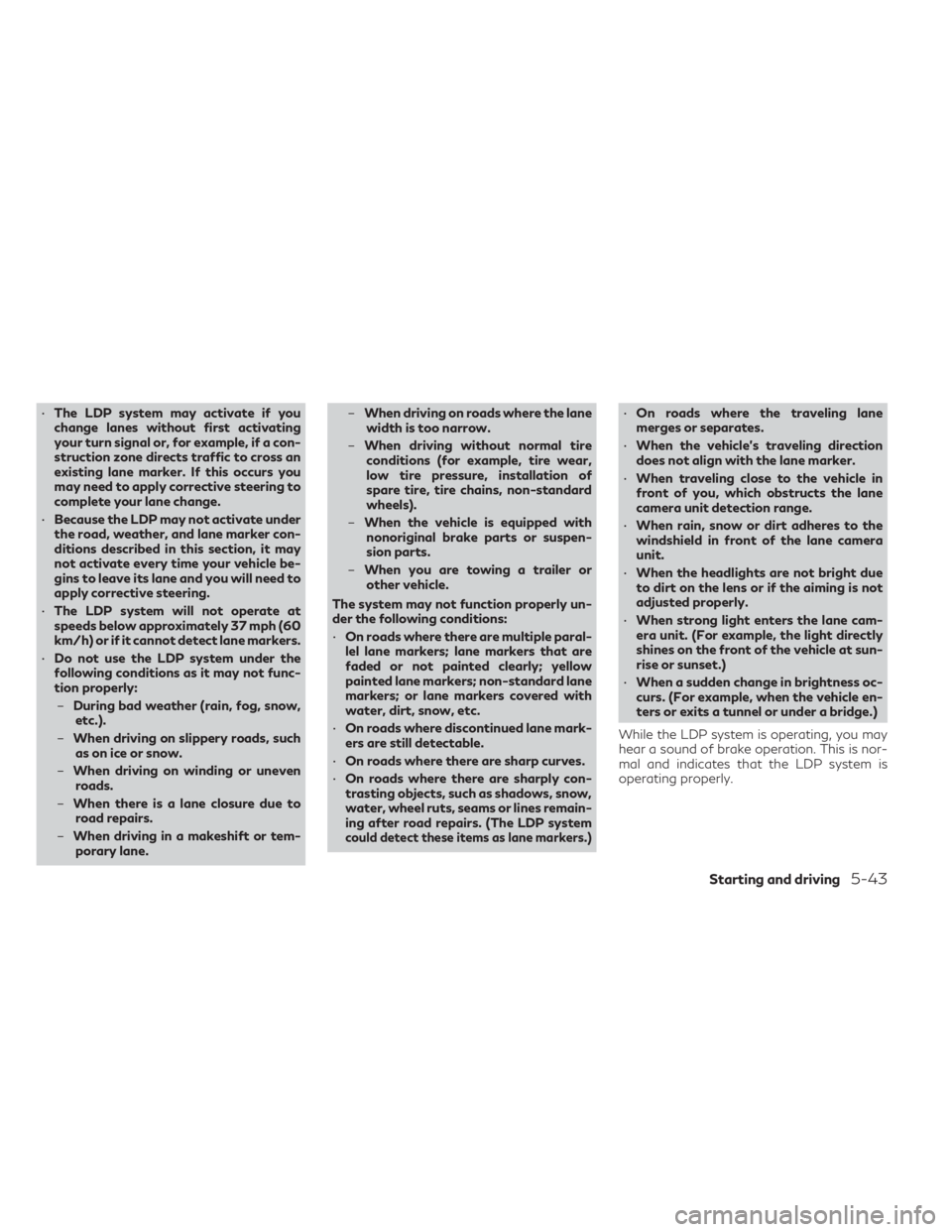
•The LDP system may activate if you
change lanes without first activating
your turn signal or, for example, if a con-
struction zone directs traffic to cross an
existing lane marker. If this occurs you
may need to apply corrective steering to
complete your lane change.
• Because the LDP may not activate under
the road, weather, and lane marker con-
ditions described in this section, it may
not activate every time your vehicle be-
gins to leave its lane and you will need to
apply corrective steering.
• The LDP system will not operate at
speeds below approximately 37 mph (60
km/h) or if it cannot detect lane markers.
• Do not use the LDP system under the
following conditions as it may not func-
tion properly:
– During bad weather (rain, fog, snow,
etc.).
– When driving on slippery roads, such
as on ice or snow.
– When driving on winding or uneven
roads.
– When there is a lane closure due to
road repairs.
– When driving in a makeshift or tem-
porary lane. –
When driving on roads where the lane
width is too narrow.
– When driving without normal tire
conditions (for example, tire wear,
low tire pressure, installation of
spare tire, tire chains, non-standard
wheels).
– When the vehicle is equipped with
nonoriginal brake parts or suspen-
sion parts.
– When you are towing a trailer or
other vehicle.
The system may not function properly un-
der the following conditions:
• On roads where there are multiple paral-
lel lane markers; lane markers that are
faded or not painted clearly; yellow
painted lane markers; non-standard lane
markers; or lane markers covered with
water, dirt, snow, etc.
• On roads where discontinued lane mark-
ers are still detectable.
• On roads where there are sharp curves.
• On roads where there are sharply con-
trasting objects, such as shadows, snow,
water, wheel ruts, seams or lines remain-
ing after road repairs. (The LDP system
could detect these items as lane markers.)
• On roads where the traveling lane
merges or separates.
• When the vehicle’s traveling direction
does not align with the lane marker.
• When traveling close to the vehicle in
front of you, which obstructs the lane
camera unit detection range.
• When rain, snow or dirt adheres to the
windshield in front of the lane camera
unit.
• When the headlights are not bright due
to dirt on the lens or if the aiming is not
adjusted properly.
• When strong light enters the lane cam-
era unit. (For example, the light directly
shines on the front of the vehicle at sun-
rise or sunset.)
• When a sudden change in brightness oc-
curs. (For example, when the vehicle en-
ters or exits a tunnel or under a bridge.)
While the LDP system is operating, you may
hear a sound of brake operation. This is nor-
mal and indicates that the LDP system is
operating properly.
Starting and driving5-43
Page 286 of 542
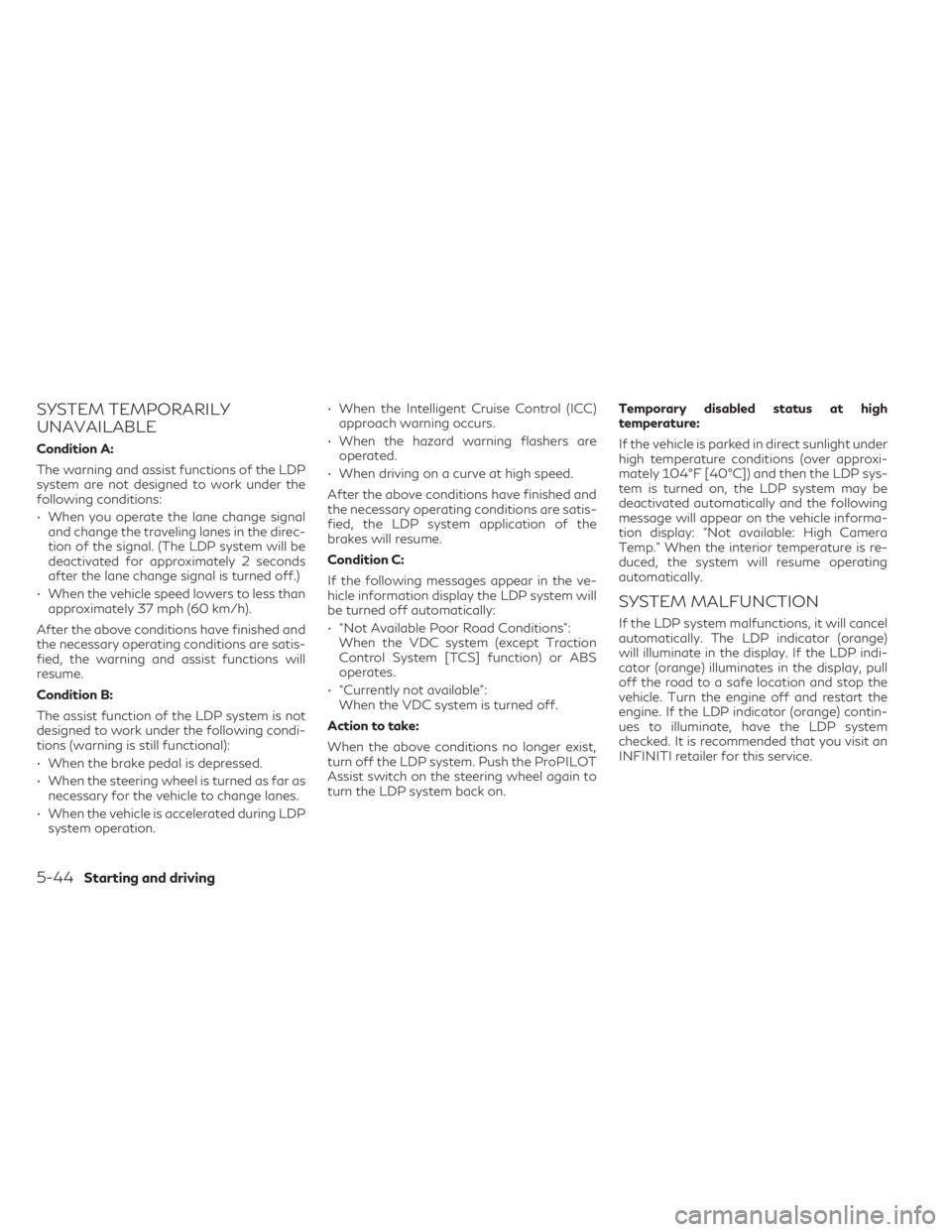
SYSTEM TEMPORARILY
UNAVAILABLE
Condition A:
The warning and assist functions of the LDP
system are not designed to work under the
following conditions:
• When you operate the lane change signaland change the traveling lanes in the direc-
tion of the signal. (The LDP system will be
deactivated for approximately 2 seconds
after the lane change signal is turned off.)
• When the vehicle speed lowers to less than approximately 37 mph (60 km/h).
After the above conditions have finished and
the necessary operating conditions are satis-
fied, the warning and assist functions will
resume.
Condition B:
The assist function of the LDP system is not
designed to work under the following condi-
tions (warning is still functional):
• When the brake pedal is depressed.
• When the steering wheel is turned as far as necessary for the vehicle to change lanes.
• When the vehicle is accelerated during LDP system operation. • When the Intelligent Cruise Control (ICC)
approach warning occurs.
• When the hazard warning flashers are operated.
• When driving on a curve at high speed.
After the above conditions have finished and
the necessary operating conditions are satis-
fied, the LDP system application of the
brakes will resume.
Condition C:
If the following messages appear in the ve-
hicle information display the LDP system will
be turned off automatically:
• “Not Available Poor Road Conditions”: When the VDC system (except Traction
Control System [TCS] function) or ABS
operates.
• “Currently not available”: When the VDC system is turned off.
Action to take:
When the above conditions no longer exist,
turn off the LDP system. Push the ProPILOT
Assist switch on the steering wheel again to
turn the LDP system back on. Temporary disabled status at high
temperature:
If the vehicle is parked in direct sunlight under
high temperature conditions (over approxi-
mately 104°F [40°C]) and then the LDP sys-
tem is turned on, the LDP system may be
deactivated automatically and the following
message will appear on the vehicle informa-
tion display: “Not available: High Camera
Temp.” When the interior temperature is re-
duced, the system will resume operating
automatically.
SYSTEM MALFUNCTION
If the LDP system malfunctions, it will cancel
automatically. The LDP indicator (orange)
will illuminate in the display. If the LDP indi-
cator (orange) illuminates in the display, pull
off the road to a safe location and stop the
vehicle. Turn the engine off and restart the
engine. If the LDP indicator (orange) contin-
ues to illuminate, have the LDP system
checked. It is recommended that you visit an
INFINITI retailer for this service.
5-44Starting and driving
Page 289 of 542

1. Side Indicator Light
2. BSW Indicator
BSW SYSTEM OPERATION
The BSW system operates above approxi-
mately 20 mph (32 km/h).
If the radar sensors detect a vehicle in the
detection zone, the side indicator light
O1
illuminates. If the turn signal is then activated,
the system chimes (twice) and the side indi-
cator light flashes. The side indicator light
continues to flash until the detected vehicle
leaves the detection zone.
The side indicator light illuminates for a few
seconds when the ignition switch is placed in
the ON position.
The brightness of the side indicator light is
adjusted automatically depending on the
brightness of the ambient light.
If a vehicle comes into the detection zone
after the driver activates the turn signal, then
only the side indicator light flashes and no
chime sounds. For additional information, see
“BSW driving situations” (P. 5-50).
LSD2921
Starting and driving5-47
Page 292 of 542

BSW DRIVING SITUATIONS
Indicator on
Indicator off
Indicator flashing
Another vehicle approaching from
behind
Illustration 1:The side indicator light illumi-
nates if a vehicle enters the detection zone
from behind in an adjacent lane.
Illustration 2:If the driver activates the turn
signal when another vehicle is in the detec-
tion zone, then the system chimes (twice) and
the side indicator light flashes.
NOTE:
• The radar sensors may not detect vehicles which are approaching rapidly from
behind.
• If the driver activates the turn signal be- fore a vehicle enters the detection zone,
the side indicator light will flash but no
chime will sound when the other vehicle is
detected.
LSD2299
Illustration 1 – Approaching from behind
LSD2300
Illustration 2 – Approaching from behind
5-50Starting and driving
Page 293 of 542

Overtaking another vehicle
Illustration 3:The side BSW/RCTA indicator
light illuminates if you overtake a vehicle and
that vehicle stays in the detection zone for
approximately 2 seconds. Illustration 4:
If the driver activates the turn
signal while another vehicle is in the detection
zone, then the system chimes (twice) and the
side BSW/RCTA indicator light flashes.
NOTE:
• When overtaking several vehicles in a row, the vehicles after the first vehicle may not
be detected if they are traveling close
together.
• The radar sensors may not detect slower moving vehicles if they are passed quickly. • If the driver activates the turn signal be-
fore a vehicle enters the detection zone,
the side BSW/RCTA indicator light will
flash but no chime will sound when the
other vehicle is detected.
LSD2302
Illustration 3 – Overtaking another vehicle
LSD2303
Illustration 4 – Overtaking another vehicle
Starting and driving5-51
Page 294 of 542

Entering from the side
Illustration 5:The side BSW/RCTA indicator
light illuminates if a vehicle enters the detec-
tion zone from either side. Illustration 6:
If the driver activates the turn
signal while another vehicle is in the detection
zone, then the system chimes (twice) and the
side BSW/RCTA indicator light flashes.
NOTE:
• If the driver activates the turn signal be- fore a vehicle enters the detection zone,
the side BSW/RCTA indicator light will
flash but no chime will sound when the
other vehicle is detected. • The radar sensors may not detect a vehicle
which is traveling at about the same speed
as your vehicle when it enters the detec-
tion zone.
SYSTEM TEMPORARILY
UNAVAILABLE
When radar blockage is detected, the system
will be deactivated automatically. The “Un-
available: Side Radar Obstruction” warning
message will appear in the vehicle informa-
tion display.
The system is not available until the condi-
tions no longer exist.
The radar sensors may be blocked by tempo-
rary ambient conditions such as splashing
water, mist or fog. The blocked condition
may also be caused by objects such as ice,
frost or dirt obstructing the radar sensors.
NOTE:
If the BSW system stops working, the RCTA
system will also stop working.
Action to take:
When the above conditions no longer exist,
the system will resume automatically.
LSD2305
Illustration 5 – Entering from the side
LSD2308
Illustration 6 – Entering from the side
5-52Starting and driving
Page 298 of 542

BSI SYSTEM OPERATION
1. Side indicator light
2. BSW indicator3. BSI ON indicator
4. ProPILOT Assist switchThe BSI system operates above approxi-
mately 37 mph (60 km/h).
If the radar sensors detect a vehicle in the
detection zone, the side indicator light (1)
illuminates.
If the turn signal is then activated, the system
chimes (twice) and the side indicator light
flashes. The side indicator light continues to
flash until the detected vehicle leaves the
detection zone.
If the BSI system is on and your vehicle ap-
proaches a lane marker while another vehicle
is in the detection zone, the system chimes
(three times) and the side indicator light
flashes. The BSI system activates to help re-
turn the vehicle back to the center of the
driving lane. The BSI system operates regard-
less of turn signal usage.
NOTE:
• BSI warning and system application will
only be activated if the side indicator light
is already illuminated when your vehicle
approaches a lane marker. If another ve-
hicle comes into the detection zone after
your vehicle has crossed a lane marker, no
BSI warning or system application will be
activated. For additional information, see
“BSI driving situations” (P. 5-60 ).
LSD3899
5-56Starting and driving
Page 303 of 542
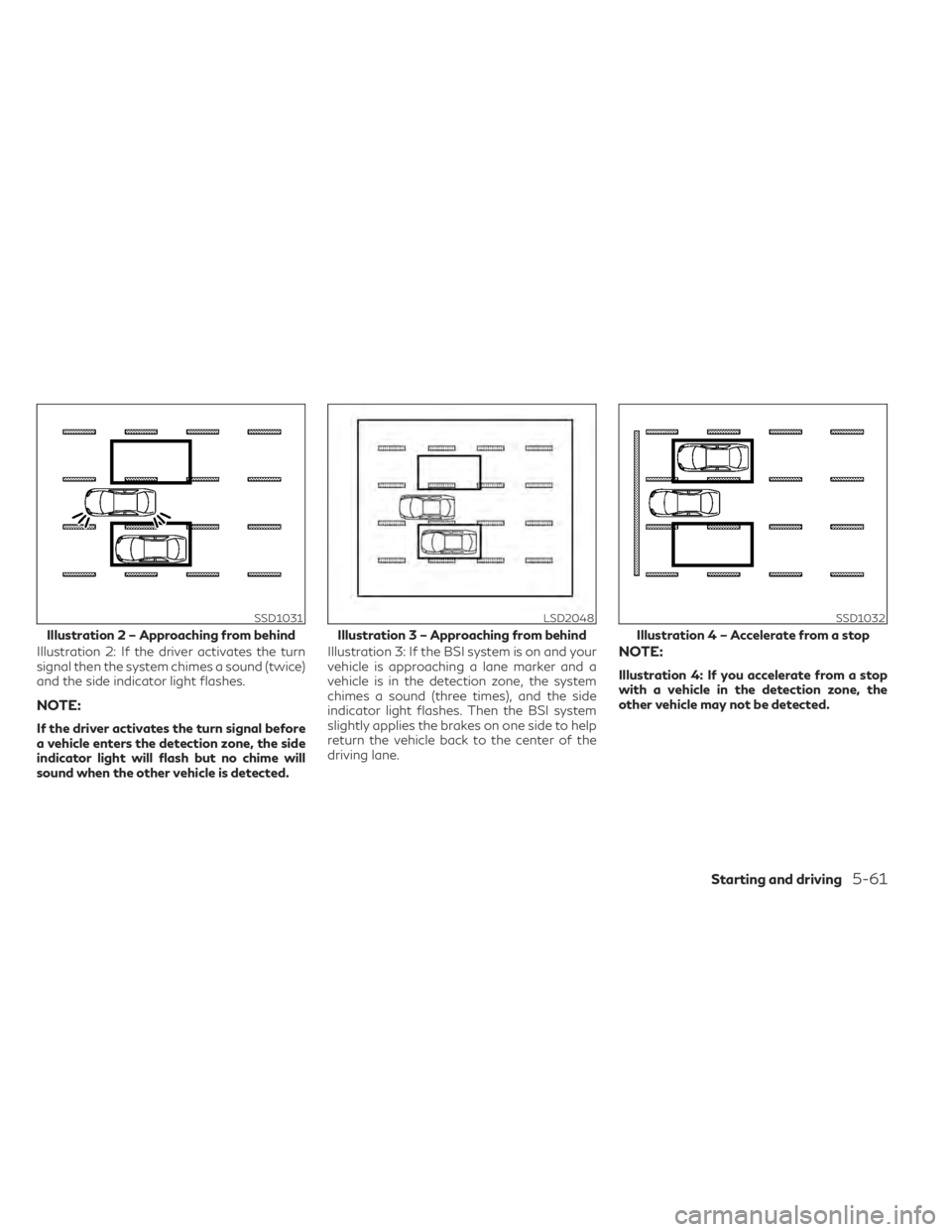
Illustration 2: If the driver activates the turn
signal then the system chimes a sound (twice)
and the side indicator light flashes.
NOTE:
If the driver activates the turn signal before
a vehicle enters the detection zone, the side
indicator light will flash but no chime will
sound when the other vehicle is detected.Illustration 3: If the BSI system is on and your
vehicle is approaching a lane marker and a
vehicle is in the detection zone, the system
chimes a sound (three times), and the side
indicator light flashes. Then the BSI system
slightly applies the brakes on one side to help
return the vehicle back to the center of the
driving lane.
NOTE:
Illustration 4: If you accelerate from a stop
with a vehicle in the detection zone, the
other vehicle may not be detected.
SSD1031
Illustration 2 – Approaching from behind
LSD2048
Illustration 3 – Approaching from behind
SSD1032
Illustration 4 – Accelerate from a stop
Starting and driving5-61